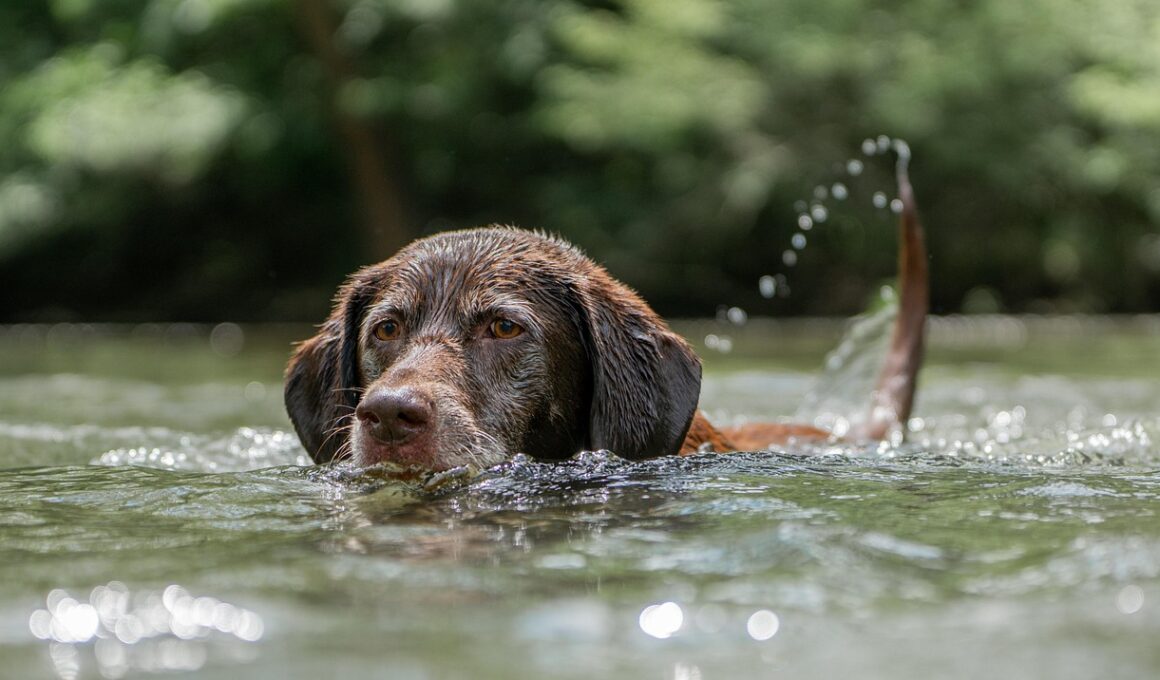Hydrotherapy in Canine Sports Rehabilitation: What You Need to Know
Hydrotherapy is a progressive and vital component of canine sports rehabilitation. It allows dogs to recover from various injuries while minimizing the risk of further damage. Water provides a low-impact environment, making it an ideal medium for rehabilitation. Dogs can exercise without putting excessive strain on their joints. This method is especially beneficial for senior dogs or those recovering from surgery. Hydrotherapy sessions can help improve muscle strength and endurance, enhancing your dog’s overall mobility. Moreover, it aids in pain relief through the buoyancy of water, which reduces feelings of discomfort during exercise. Such therapy primarily focuses on building muscle strength in a controlled setting, ensuring every movement is beneficial. Never underestimate the significance of professional supervision during hydrotherapy sessions; experienced practitioners can tailor the program to meet specific needs and ensure safety. Whether your dog is an active athlete or a recovering pet, hydrotherapy can play a crucial role in their rehabilitation journey, providing effective treatment without compromise. Always consult with a veterinarian before beginning any new rehabilitation program to ensure it aligns with your dog’s health requirements.
Many factors contribute to the effectiveness of hydrotherapy in canine sports rehabilitation. Notably, dogs suffering from joint issues or those that require post-operative recovery can experience remarkable progress through this method. The controlled water temperature helps comfort and soothes aching muscles, promoting blood circulation. When water is heated, it can often stimulate blood flow, aiding in the healing process. During hydrotherapy, dogs typically undertake various exercises to enhance their physical condition. Activities may include swimming, walking on underwater treadmills, or using flotation devices designed for therapy. A knowledgeable therapist can modify these exercises according to your dog’s specific needs. Furthermore, regular sessions can foster better mental health. While performing exercises in the water, dogs enjoy physical activity, which releases endorphins, improving their mood and reducing anxiety. Many dogs find hydrotherapy enjoyable, which encourages continual participation in their rehabilitation program. This aspect is essential as enthusiasm can aid in the recovery process. By integrating hydrotherapy into your dog’s routine, you support not only their physical recovery but also their emotional well-being.
Techniques and Exercises in Hydrotherapy
Various techniques and exercises are used in hydrotherapy to maximize your dog’s recovery. Each method targets specific areas and functions, allowing tailored rehabilitation to meet individual recovery goals. Swimming is perhaps the most common but is just one option. In addition to basic swimming, dogs may engage in activities using flotation devices or toys to encourage proper movements. Some therapies use underwater treadmills, where the dog walks against water resistance, promoting strength without added stress. This approach is advantageous for building endurance and rehabilitating injured limbs. Physical therapists often utilize warm water to soothe pain and relax muscles, while cool water can lessen inflammation and promote circulation. Incorporating these two temperatures within sessions can enhance recovery efficacy. Additionally, therapists may use resistance tools, such as aquatic bands or belts, that further boost muscle engagement. Regular monitoring and adjustments by a qualified professional or therapist ensure best results while prioritizing your dog’s safety. These methods offer a comprehensive approach to canine rehabilitation, ultimately leading toward a successful recovery journey for your furry friend.
Choosing an appropriate facility for hydrotherapy is crucial to ensure your dog’s safety and comfort during treatment. Look for accredited professionals with experience in canine rehabilitation. Don’t hesitate to ask about credentials and their experience with specific injuries or conditions. A reputable hydrotherapy center should have qualified staff who understand the nuances of canine anatomy and rehabilitation protocols. They should also have access to specialized equipment designed for dog therapy, such as the underwater treadmill mentioned previously. Before enrolling your dog, consider scheduling a consultation to observe the facility and assess how staff interacts with the dogs. Observing a typical session can give you insight into their practices and care protocols. It’s essential to choose a facility that prioritizes the comfort and well-being of all pets. Ask about their approach to safety limits and canine behavior during hydrotherapy sessions. Following these recommendations can lead to a more successful rehabilitation experience for your dog. Feeling confident in their care, you can better support your furry friend throughout each stage of recovery.
Benefits Beyond Physical Recovery
Hydrotherapy offers numerous benefits beyond just physical rehabilitation; it significantly enhances the overall quality of life for canines. Through consistent sessions, dogs can experience reduced stiffness and increased flexibility, improving their comfort during everyday activities. Another often-overlooked advantage is improving a dog’s range of motion, fostering a more active and engaged lifestyle. For athletic dogs, hydrotherapy can serve as a means to enhance performance through endurance training and muscle development. Furthermore, engaging in hydrotherapy helps alleviate anxiety and stress, particularly for dogs recovering from traumatic experiences or surgeries. It serves as an enjoyable activity that owners and dogs can share, enhancing their bond. Participating in such sessions regularly can instill a sense of routine and purpose. Regular exercise can also combat obesity, maintaining your dog’s physical well-being over time. Coupled with proper nutritional plans, hydrotherapy can keep your dog in optimal health. The long-term implications of a balanced exercise regime like hydrotherapy can significantly extend your dog’s active years while reducing the likelihood of recurring injuries or ailments.
Many pet owners express their concerns about the costs involved in hydrotherapy; it is essential to view this as an investment in your dog’s health. While it may seem like a significant financial commitment initially, the benefits often outweigh the expenses. Investing in your dog’s rehabilitation can expedite recovery time and reduce the need for more invasive procedures down the line. Additionally, the cost can vary based on treatment frequency, location, and the facility you choose. Some pet insurance providers may cover hydrotherapy under specific conditions, so it’s advisable to review your policy or reach out to your provider for clarity. Partnering with your veterinarian can also help devise a plan that aligns with your financial situation. Discuss any concerns you have regarding the cost of care; they may provide options to facilitate the process. As the old saying goes, ‘an ounce of prevention is worth a pound of cure.’ Ensuring proper rehabilitation through hydrotherapy can ultimately ensure a happier, healthier life for your cherished canine companion.
Conclusion on Hydrotherapy’s Role
Hydrotherapy plays an indispensable role in canine sports rehabilitation, providing multifaceted advantages for dogs of all ages and conditions. From alleviating pain to enhancing mobility, this method supports both physical and psychological healing processes. By exploring various techniques and exercising in a controlled environment, dogs find renewed joy in movement. Such enthusiasm can be vital for recovery, highlighting the importance of finding qualified therapists to guide your dog through their rehabilitation journey. Fostering a recovery program tailored to your dog’s unique needs can yield impressive results in improving their quality of life. Hydrotherapy not only enhances a dog’s physical capabilities but also strengthens their bond with their owners and promotes emotional well-being. Whether your dog is an athlete striving for peak performance or a family pet recovering from an injury, hydrotherapy should be regarded as a critical component of their complete care regimen. Always consult with professionals and conduct thorough research to ensure a positive experience for your dog. By investing time and effort into proper rehabilitation, you prepare your cherished companion for a happy, active future.


